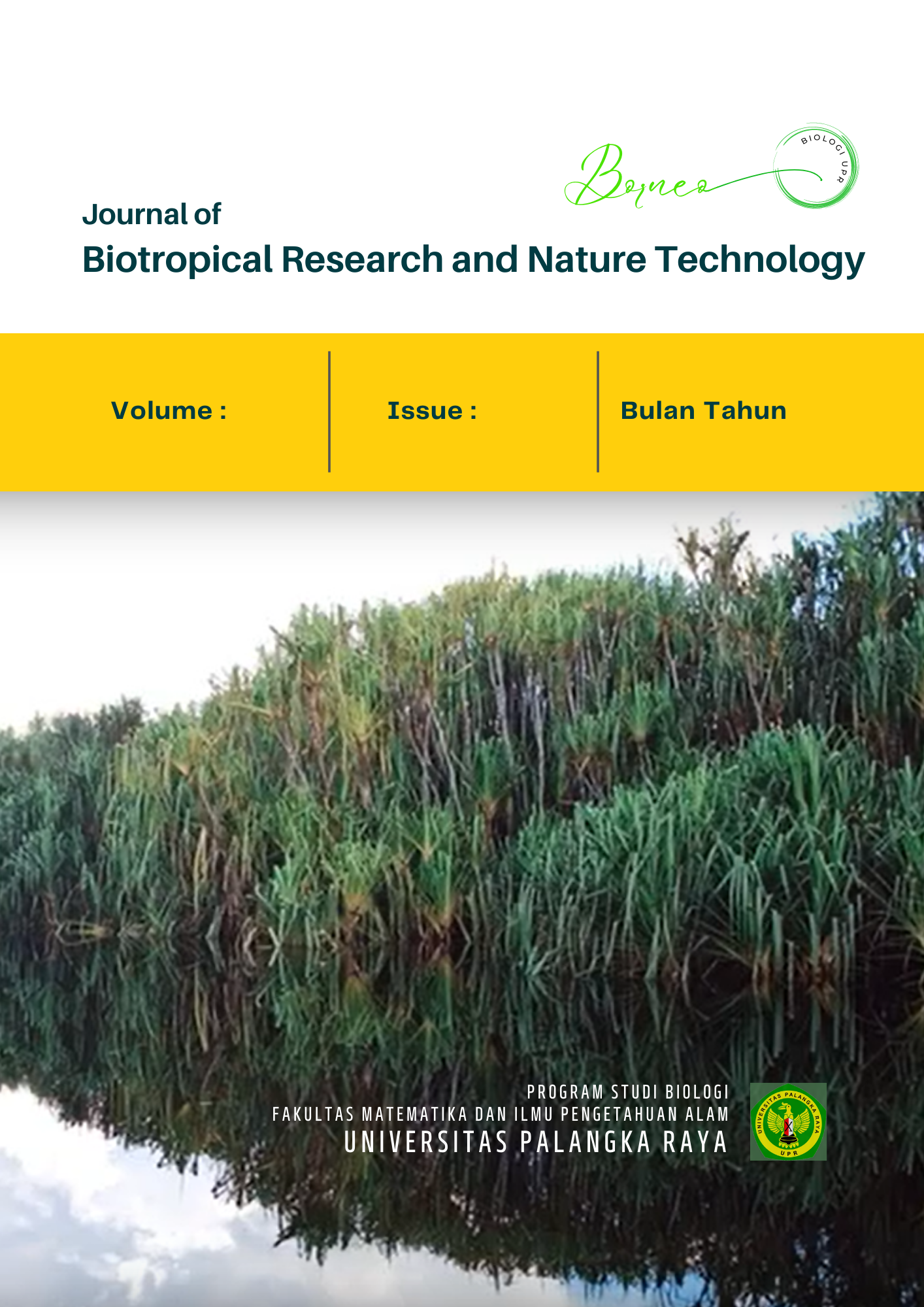A Comparative Study on the Effectiveness of Azotobacter chroococcum and Beijerinckia indica as Biofertilizers for Enhancing the Growth of Alternanthera ficoidea
DOI:
https://doi.org/10.52850/borneo.v3i2.19878Keywords:
Azotobacter chroococcum, Beijerinckia indica, Alternanthera ficoidea, Plant HeightAbstract
The increasing global demand for food has driven the development of environmentally friendly technologies in agriculture, one of which involves the use of nitrogen-fixing bacteria-based biofertilizers. This study aims to evaluate the effectiveness of two nitrogen-fixing bacterial species, Azotobacter chroococcum and Beijerinckia indica, in enhancing the growth of red spinach (Alternanthera ficoidea) in acidic soil conditions. The results revealed that treatments with various concentrations of bacterial inoculants did not have a statistically significant effect on plant height, based on a two-way ANOVA test (α > 0.05). However, descriptively, B. indica demonstrated more optimal performance compared to A. chroococcum and their combination, particularly at a concentration of 15 mL, which produced the highest plant height (31.00 cm). B. indica exhibited better survival and functionality in acidic soil (pH 4–4.5), whereas A. chroococcum was less efficient under such conditions. These findings underscore the importance of selecting bacterial strains that are compatible with specific soil characteristics to enhance the efficacy of biofertilizers and support the growth of ornamental plants such as A. ficoidea.
Downloads
References
E. T. Wibowo, “Pembangunan Ekonomi Pertanian Digital Dalam Mendukung Ketahanan Pangan (Studi di Kabupaten Sleman: Dinas Pertanian, Pangan, dan Perikanan, Daerah Istimewa Yogyakarta),” J. Ketahanan Nas., vol. 26, no. 2, p. 204, Aug. 2020, doi: 10.22146/jkn.57285.
S. Y. Setiani, T. Pratiwi, and A. R. Fitrianto, “Tenaga Muda Pertanian dan Ketahanan Pangan di Indonesia,” Cakrawala, vol. 15, no. 2, pp. 95–108, Dec. 2021, doi: 10.32781/cakrawala.v15i2.386.
R. V. Aulia, S. A. Pratiwi, C. A. Putra, H. F. Al Rasyid, and R. J. Barrulanda, “Pemanfaatan Limbah Organik Pertanian Menjadi Pupuk Organik Cair di Desa Musir Lor Kabupaten Nganjuk,” J. Pengabdi. Masy. Inov. Indones., vol. 2, no. 3, pp. 383–390, 2024, doi: 10.54082/jpmii.472.
R. Hayati, M. Mulyadi, U. M. Bengkulu, and B. Tengah, “Pemanfaatan kulit durian menjadi pupuk organik yang memiliki nilai ekonomi tinggi bermanfaat untuk menyuburkan tanaman,” vol. 3, no. 1, pp. 131–145, 2025.
E. Twenty, A. Zendrato, N. K. Lase, P. S. Agroteknologi, U. Nias, and S. Utara, “Peran Mikroorganisme dalam Meningkatkan Produktivitas Tanaman : Pendekatan Bioteknologi Berbasis Mikrobiologi Pertanian,” vol. 2, 2025.
E. Tando, “Upaya Efisiensi Dan Peningkatan Ketersediaan Nitrogen Dalam Tanah Serta Serapan Nitrogen Pada Tanaman Padi Sawah (Oryza sativa L.),” Buana Sains, vol. 18, no. 2, p. 171, 2019, doi: 10.54082/jpmii.472.
E. Husen, Surono, E. Pratiwi, and L. R. Widowati, Metode Analisis Biologi Tanah Edisi 2, vol. 3, no. February. 2022.
D. Suryadi, L. Mawarni, and J. Ginting, “Pengaruh Pemberian Azotobacter chroococcum Terhadap Pertumbuhan Dua Varietas Kelapa Sawit di Tanah Ultisol Pada Pre Nursery,” J. Agroekoteknologi, vol. 8, no. 1, pp. 35–42, 2020, doi: 10.32734/jaet.
M. Miransari, “Plant Growth Promoting Rhizobacteria,” J. Plant Nutr., vol. 37, no. 14, pp. 2227–2235, 2014, doi: 10.1080/01904167.2014.920384.
J. Nainggolan, “Pemanfaatan Mikroorganisme Tanah untuk Meningkatkan Kualitas Tanah dan Produktivitas Pertanian,” pp. 1–7.
F. Sapalina, E. Noviandi Ginting, and F. Hidayat, “Bakteri Penambat Nitrogen Sebagai Agen Biofertilizer,” War. Pus. Penelit. Kelapa Sawit, vol. 27, no. 1, pp. 41–50, 2022, doi: 10.22302/iopri.war.warta.v27i1.80.
R. K. Singla et al., “The Genus Alternanthera: Phytochemical and Ethnopharmacological Perspectives,” Front. Pharmacol., vol. 13, no. April, 2022, doi: 10.3389/fphar.2022.769111.
Satrio Adil Pamungkas, Indun Dewi Puspita, and Ustadi Ustadi, “Pengaruh pH, Suhu Dan Jenis Substrat Terhadap Aktivitaskitinase Bacillus sp. RNT9,” Indones. J. Fish. Sci. Technol., vol. 19, no. 1, pp. 29–39, 2023.
M. R. Ramadhan, D. N. R. Sari, M. S. Aswan, and S. D. Anitasari, “The Effect of Agung Semeru Banana Peel Extract as Biostimulation of Indegenous Bacteria in Reducing Ammonia,” J. Biota, vol. 9, no. 1, pp. 38–44, 2023, doi: 10.19109/biota.v9i1.13831.
N. Firdausi, “Pengaruh Kombinasi Media Pembawa Pupuk Hayati Bakteri Pelarut Fosfat Bacillus sp Terhadap Pertumbuhan Kacang Tanah ( Arachis hypogea),” pp. 1–89, 2016.
I. D. G. Satrya, T. S. Kaihatu, and L. Pranata, “Upaya Pembinaan Masyarakat Dalam Rangka Pengembangan Desa Ekowisata Di Dusun Mendiro, Desa Panglungan, Kecamatan Wonosalam, Kabupaten Jombang,” J. Terap. Abdimas, vol. 4, no. 1, p. 90, Jan. 2019, doi: 10.25273/jta.v4i1.3826.
F. Rohmaniya, R. Jumadi, and E. S. Redjeki, “Respon Pertumbuhan Dan Hasil Tanam Jagung Manis (Zea mays saccharata Sturt) Pada Pemberian Pupuk Kandang Kambing Dan Pupuk NPK,” Trop. Indones. J. Trop. Crops, vol. 6, no. 1, p. 37, 2023, doi: 10.30587/tropicrops.v6i1.5376.
R. Mahtum, D. Sudiarti, and I. Bukhori Muslim, “Efektivitas Penggunaan Pupuk Organik Hayati (POH) dan Cedawan Mikoriza Arbuskula (CMA) terhadap Produktivitas Tanaman Terung Hijau (Solanum melongena L.),” J. BIOSHELL, vol. 8, no. 2, pp. 41–49, Oct. 2019, doi: 10.36835/bio.v8i2.770.
R. Hergiyani, Y. S. Darmanto, and L. Purnamayati, “The Effect of Zirconium Tanning Against Tensile Strength Test, Strength Test of Tear, Glide Test, and Wrinkle Temperature Test on Different Fish Types,” SAINTEK Perikan. Indones. J. Fish. Sci. Technol., vol. 13, no. 2, p. 105, Oct. 2018, doi: 10.14710/ijfst.13.2.105-110.
Ni Made Susilawati and Meliance Bria, “Penyuluhan Infeksi Kecacingan Pada Anak-Anak Pemulung di Tempat Pembuangan Akhir Alak Kota Kupang,” Perigel J. Penyul. Masy. Indones., vol. 2, no. 2, pp. 31–39, Jun. 2023, doi: 10.56444/perigel.v2i2.841.
D. N. Rikhmasari, S. Dian Anitasari, and M. S. Aswan, “Pemanfaatan Beijerinckia indica dalam Meningkatkan Pertumbuhan Jumlah Daun Alternanthera ficoidea,” BIO-CONS J. Biol. Dan Konserv., vol. 5, no. 1, pp. 252–259, Jun. 2023, doi: 10.31537/biocons.v5i1.1101.
S. Ismiani and E. D. I. Wilujeng, “Analisis Viabilitas Isolat Bakteri Penambat Nitrogen Azotobacter 33 pada Bahan Pembawa dan Suhu Penyimpanan yang Berbeda,” Agropross Natl. Conf. Proc. Agric., pp. 538–543, 2023, doi: 10.25047/agropross.2023.500.
I. Razali and D. Fithria, “Pengaruh Pemberian Pupuk Organik Cair Ekstrak Daun Gamal (Gliricidia sepium) Terhadap Pertumbuhan Tanaman Kangkung Darat (Ipomoea reptans Poir.),” Biofarm J. Ilm. Pertan., vol. 19, no. 1, p. 24, 2023, doi: 10.31941/biofarm.v19i1.2695.
T. Prakoso, H. Alpandari, and H. H. H Sridjono, “Respon Pemberian Unsur Hara Makro Essensial Terhadap Pertumbuhan Tanaman Jagung (Zea mays),” Muria J. Agroteknologi MJ-Agroteknologi, vol. 1, no. 1, pp. 8–13, 2022, doi: 10.24176/mjagrotek.v1i1.8217.
A. Achmadi, M. Mahdiannoor, and N. Istiqomah, “Pertumbuhan dan Hasil Dua Varietas Jagung Manis terhadap Pemberian Pupuk Hayati pada Lahan Rawa Lebak,” RAWA SAINS J. SAINS STIPER AMUNTAI, vol. 7, no. 1, pp. 493–503, Jun. 2017, doi: 10.36589/rs.v7i1.69.
R. Rifai, M., H. Widowati, and A. Sutanto, “Uji Sinergis Konsorsia Bakteri Indigen Lcn Berkonsorsia Bakteri Tanah Di Kebun Percobaan Universitas Muhammadiyah Metro Untuk Penyusunan Panduan Praktikum Mikrobiologi,” Biolova, vol. 1, no. 2, pp. 88–95, 2020, doi: 10.24127/biolova.v1i2.303.
Downloads
Published
How to Cite
Issue
Section
License
Copyright (c) 2025 Dwi Nur Rikhma Sari, Dinani Amorim

This work is licensed under a Creative Commons Attribution-ShareAlike 4.0 International License.
- Authors retain copyright and acknowledge that the Journal of Multidisciplinary Applied Natural Science is the first publisher, licensed under a Creative Commons Attribution-Share Alike 4.0 (CC BY-SA).
- Authors are able to enter into separate, additional contractual arrangements for the non-exclusive distribution of the journal's published version of the work (e.g., post it to an institutional repository or publish it in a book), with an acknowledgment of its initial publication in this journal.
- Authors are permitted and encouraged to post their work online (e.g., in institutional repositories or on their website) prior to and during the submission process, as it can lead to productive exchanges and earlier and greater citation of published work.








